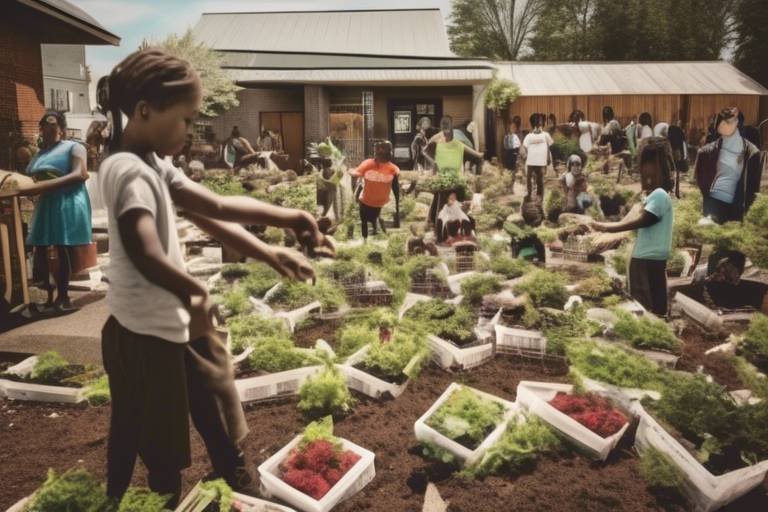How to Make Your Coffee Routine More Sustainable
Are you a coffee lover looking to make your daily brew a bit greener? You're not alone! More and more people are realizing that their coffee habits can have a significant impact on the environment. From the way we source our beans to the methods we use to brew, there are countless opportunities to make our coffee routines more sustainable. In this article, we’ll explore practical ways to reduce the environmental impact of your coffee habits, aiming for a greener coffee experience.
When it comes to sustainability, the first step starts with the coffee beans themselves. Selecting coffee that is ethically sourced and certified can significantly reduce your carbon footprint. But what does that mean? Certifications like Fair Trade, Rainforest Alliance, and Organic not only ensure that farmers are paid fairly but also promote environmentally friendly farming practices. For instance, Fair Trade certified coffee guarantees that farmers receive a minimum price for their beans, while Organic coffee is grown without harmful pesticides and fertilizers. By choosing coffee with these certifications, you’re not just enjoying a good cup of joe; you’re also supporting sustainable agriculture.
Now that you’ve got your sustainable beans, let’s talk about how you brew your coffee. Traditional coffee machines can consume a lot of energy and often create waste with single-use filters. Instead, consider brewing methods that minimize waste and energy consumption. Techniques like French press or pour-over can be much more sustainable. Not only do they require less electricity, but they also allow you to control the amount of coffee you make, reducing waste. Plus, they often produce a richer flavor, giving you a more enjoyable coffee experience!
One of the easiest ways to cut down on waste is by switching to reusable coffee filters. Single-use paper filters may seem harmless, but they contribute to a significant amount of waste over time. By using a reusable filter, you can drastically reduce this waste. There are several options available, including metal and cloth filters, each offering unique benefits. For example, metal filters allow more oils through, resulting in a richer flavor, while cloth filters can produce a smoother cup. The best part? You can use them over and over again!
When choosing a reusable filter, consider the materials used. Here’s a quick comparison:
| Type | Material | Flavor Impact | Sustainability |
|---|---|---|---|
| Metal Filter | Stainless Steel | Rich, full-bodied | High |
| Cloth Filter | Cotton or Hemp | Smooth, delicate | Moderate |
To ensure your reusable filters last and perform well, proper care is essential. After each use, rinse your filter thoroughly to remove coffee oils and grounds. Occasionally, you can soak it in a mixture of vinegar and water to eliminate any stubborn residues. Keeping your filters clean not only extends their lifespan but also enhances the flavor of your coffee.
Water conservation is another key aspect of sustainable coffee brewing. Did you know that the average coffee maker uses about 20% more water than necessary? To minimize waste, try measuring the exact amount of water you need for your brew. Additionally, consider using leftover water from cooking or even rainwater for brewing. Every drop counts!
After enjoying your coffee, don’t toss those grounds in the trash! Coffee grounds can be a valuable addition to your compost pile. They are rich in nitrogen, which is essential for healthy compost. By composting your used grounds, you’re not only reducing waste but also enriching your garden soil. Just mix them with other compost materials, and let nature do its work!
But wait, there’s more! You can also use coffee grounds directly in your garden. They can enhance soil quality, improve drainage, and even deter pests. Just sprinkle them around your plants or mix them into the soil. Your plants will thank you, and you’ll be reducing waste at the same time!
Beyond gardening, used coffee grounds have a variety of creative applications. Here are a few ideas:
- Natural Cleaning Products: Their gritty texture makes them an excellent scrubbing agent for pots and pans.
- Beauty Treatments: Use them as an exfoliant in your skincare routine.
- Odor Neutralizer: Place them in your fridge or freezer to absorb unwanted smells.
By finding innovative ways to use your used coffee grounds, you’re promoting a zero-waste lifestyle and ensuring that nothing goes to waste.
Q: What are the best certifications to look for when buying sustainable coffee?
A: Look for certifications like Fair Trade, Rainforest Alliance, and Organic to ensure that your coffee is ethically sourced and environmentally friendly.
Q: How can I make my coffee brewing more energy-efficient?
A: Consider using manual brewing methods like French press or pour-over, which consume less energy than traditional coffee machines.
Q: What can I do with used coffee grounds besides composting?
A: Used coffee grounds can be used in gardening, as natural cleaning products, or even in beauty treatments. Get creative!

Choosing Sustainable Coffee Beans
When it comes to making your coffee routine more sustainable, one of the most impactful choices you can make is in the selection of your coffee beans. Choosing ethically sourced and certified coffee beans not only supports sustainable farming practices but also helps in reducing your overall carbon footprint. But what does it mean for coffee to be sustainable? It’s all about the journey your coffee takes from the farm to your cup, and understanding the certifications that ensure this journey is environmentally friendly is vital.
There are several certifications you might come across while shopping for coffee, each with its own set of standards. For instance, Fair Trade certification ensures that farmers receive a fair price for their beans, promoting social and economic equity. On the other hand, Rainforest Alliance certification focuses on protecting biodiversity and ensuring sustainable farming practices that benefit both the environment and the farmers. Then there’s Organic certification, which guarantees that the coffee is grown without synthetic fertilizers and pesticides, making it a healthier choice for both you and the planet.
Understanding these certifications can feel overwhelming, but it’s worth the effort. When you choose coffee with these labels, you are not just making a choice for your taste buds; you are actively participating in a global movement towards sustainability. You might be wondering, “How can I find this certified coffee?” The good news is that many local coffee shops and even grocery stores are increasingly stocking sustainably sourced options. Look for these labels on the packaging, or ask your barista for recommendations—most coffee enthusiasts would be happy to share their knowledge!
Moreover, consider buying directly from local roasters or farmers’ markets. This not only supports local economies but also reduces the carbon emissions associated with transporting coffee over long distances. Plus, you often get fresher beans that taste better! If you’re really keen on diving deeper into the world of sustainable coffee, you could even explore options like single-origin coffee, which comes from one location and often reflects the unique qualities of that region, making your coffee experience not just sustainable but also richer and more flavorful.
In summary, choosing sustainable coffee beans is a crucial step in reducing your environmental impact. By selecting beans that are ethically sourced and certified, you can enjoy your daily cup of joe while also contributing to a healthier planet. So, the next time you brew a cup, take a moment to appreciate not just the flavor but the journey those beans have taken to reach you. After all, every sip can make a difference!

Eco-Friendly Brewing Methods
When it comes to brewing your morning cup of coffee, did you know that the method you choose can have a significant impact on the environment? That's right! By opting for , you can enjoy your coffee while also being mindful of your carbon footprint. Traditional coffee machines often consume a lot of energy and produce waste, but there are several alternatives that are not only sustainable but can also enhance the flavor of your brew.
One popular method is the French press. This classic brewing technique involves steeping coarse coffee grounds in hot water, allowing the rich flavors to develop fully. Not only does it require no electricity, but it also produces minimal waste. You simply need your coffee grounds and hot water, making it a fantastic option for those looking to reduce their energy consumption. Additionally, the French press allows you to control the brewing time and temperature, resulting in a personalized cup of coffee every time.
Another excellent option is the pour-over method. This technique involves pouring hot water over coffee grounds in a filter, allowing the water to extract flavors as it drips through. Pour-over brewing can be incredibly satisfying, as it turns the process into a mindful ritual. Plus, with the right equipment, you can use a reusable filter, which cuts down on waste significantly. Many enthusiasts argue that pour-over brewing brings out more nuanced flavors compared to traditional methods, making it a win-win for both your taste buds and the planet.
Speaking of waste reduction, switching to reusable coffee filters can drastically cut down on single-use waste. Imagine how many paper filters end up in landfills each year! By investing in a reusable filter, you not only save money but also contribute to a healthier planet. These filters come in various materials, including metal and cloth, each offering unique benefits. Metal filters, for example, allow more oils from the coffee to pass through, resulting in a richer flavor, while cloth filters can provide a smoother taste.
Choosing the right reusable filter can be a game-changer for your coffee routine. Here’s a quick overview of the most common types:
| Type | Material | Flavor Impact |
|---|---|---|
| Metal Filter | Stainless Steel | Rich, full-bodied |
| Cloth Filter | Cotton or Hemp | Smooth, clean |
| Silicone Filter | Food-grade Silicone | Balanced |
Proper care of your reusable filters is essential for longevity and performance. For metal filters, simply rinse them under hot water after each use to remove coffee oils. If you notice any buildup, a gentle scrub with a non-abrasive sponge should do the trick. Cloth filters, on the other hand, may require a bit more attention. It's best to soak them in warm, soapy water after each use and rinse thoroughly. Remember, keeping your filters clean not only ensures the best flavor but also extends their lifespan, making them an even more sustainable choice!
In conclusion, switching to eco-friendly brewing methods is a simple yet effective way to make your coffee routine more sustainable. Whether you choose the French press, pour-over, or invest in reusable filters, each choice contributes to a healthier planet. So, why not make your morning ritual a little greener? Your taste buds—and the Earth—will thank you!

Using Reusable Filters
Switching to reusable coffee filters is one of the simplest yet most effective changes you can make to your coffee routine to promote sustainability. Imagine this: every time you brew a pot of coffee, you're not just enjoying a delicious cup; you're also contributing to a mountain of waste if you're using single-use filters. By opting for a reusable filter, you can significantly reduce your environmental impact while still enjoying that rich, aromatic brew you love.
Reusable filters come in various materials, each offering unique benefits. For instance, metal filters are durable and can last for years, allowing the oils from the coffee to pass through, which enhances flavor. On the other hand, cloth filters provide a smooth taste and are biodegradable, but they require a bit more maintenance. It's essential to choose a filter that suits your brewing style and personal preferences. Not only does this choice contribute to a greener planet, but it also enriches your coffee experience.
One of the most significant advantages of using reusable filters is the reduction in single-use waste. Consider this: if you brew coffee every day and use a paper filter each time, that adds up to over 365 filters a year! By switching to a reusable option, you can save that waste from ending up in landfills. Plus, many reusable filters are designed to be easily cleaned, making them a practical choice for any coffee lover.
When you first switch to reusable filters, you might wonder about the cleaning process. It's straightforward! After each use, simply rinse the filter under warm water to remove coffee grounds. For a deeper clean, you can soak it in a mixture of vinegar and water once a month. This not only keeps your filter in top shape but also helps to eliminate any lingering coffee oils that could affect the flavor of your next brew.
In conclusion, using reusable filters is a small change that can lead to a big difference in reducing waste and enhancing your coffee experience. So, why not take the plunge? Your taste buds and the planet will thank you!
- How do I clean my reusable coffee filter? Rinse it with warm water after each use, and soak it in vinegar and water monthly for a deeper clean.
- Can I use a reusable filter in any coffee maker? Most reusable filters are versatile and can be used in various brewing methods, but always check compatibility with your specific coffee maker.
- Do reusable filters affect the taste of coffee? Yes, they can enhance the flavor by allowing essential oils to pass through, unlike paper filters that can absorb some of those oils.

Types of Reusable Filters
When it comes to brewing your perfect cup of coffee, the type of filter you choose can dramatically affect not only the flavor of your brew but also your environmental impact. Reusable filters are a fantastic way to cut down on waste while still enjoying the rich, aromatic coffee you love. There are several types of reusable filters available, each with its unique benefits and characteristics. Understanding these options can help you make an informed decision that aligns with your sustainability goals.
One of the most popular types of reusable filters is the metal filter. Typically made from stainless steel, these filters are designed to last a lifetime. They allow oils and fine coffee particles to pass through, resulting in a fuller-bodied cup of coffee. However, they require a bit more care during cleaning to ensure that old coffee oils don’t affect the taste of your next brew. Metal filters are perfect for those who enjoy a robust flavor and want a long-lasting option.
Another excellent choice is the cloth filter. Made from organic cotton or hemp, cloth filters offer a unique brewing experience. They allow for a smooth extraction of flavors while retaining some of the oils that contribute to a rich taste. Plus, they are biodegradable, making them a sustainable option at the end of their life cycle. However, cloth filters do require regular washing and proper drying to prevent mold and maintain their effectiveness. The effort is worth it for those who prioritize both flavor and environmental responsibility.
For those who prefer convenience, silicone filters are also gaining popularity. These filters are flexible, easy to clean, and can withstand high temperatures without degrading. They are often designed to fit various coffee brewing systems, making them versatile. While they may not provide the same depth of flavor as metal or cloth filters, they are an excellent choice for busy individuals looking for a low-maintenance option.
To summarize, here’s a quick comparison of the three types of reusable filters:
| Type | Material | Flavor Profile | Maintenance |
|---|---|---|---|
| Metal Filter | Stainless Steel | Full-bodied | Requires thorough cleaning |
| Cloth Filter | Organic Cotton/Hemp | Smooth and rich | Regular washing needed |
| Silicone Filter | Silicone | Light and clean | Easy to clean |
Each type of reusable filter has its advantages, and the choice ultimately depends on your personal preferences and brewing style. By opting for these sustainable alternatives, you’re not just making a positive impact on the planet; you’re also enhancing your coffee experience. So, which filter will you choose for your next brew?
- How do I clean metal and cloth filters? Metal filters can be rinsed and scrubbed with a brush, while cloth filters should be washed with soap and water, then dried completely.
- Do reusable filters affect the taste of coffee? Yes, different materials can influence the flavor profile. Metal filters allow more oils through, while cloth filters can provide a smoother taste.
- Are silicone filters safe for brewing coffee? Absolutely! Silicone filters are designed to withstand high temperatures and are safe for coffee brewing.

Cleaning and Maintenance
When it comes to maintaining your reusable coffee filters, a little attention goes a long way. Just like you wouldn’t let your favorite mug gather dust, you shouldn't neglect the care of your filters. Regular cleaning not only ensures that your coffee tastes fresh, but it also prolongs the life of your filters, making them a more sustainable choice in the long run. So, how do you keep these eco-friendly tools in tip-top shape?
First off, it's essential to rinse your filters immediately after use. This simple step prevents coffee oils and residues from building up, which can affect the flavor of your next brew. If you’re using a metal filter, a quick rinse under warm water will usually do the trick. However, if you notice any stubborn stains or buildup, a gentle scrub with a soft brush can work wonders. For cloth filters, a quick soak in warm, soapy water can help remove any lingering odors or stains.
To keep things even cleaner, consider a deeper cleaning routine every few weeks. For metal filters, you can soak them in a mixture of vinegar and water. This not only helps to remove any oils but also acts as a natural disinfectant. Just be sure to rinse thoroughly afterward to avoid any lingering vinegar taste in your coffee. For cloth filters, you might want to toss them in the washing machine on a gentle cycle, but always check the manufacturer's instructions first to avoid any damage.
Here's a quick overview of cleaning methods for different types of filters:
| Filter Type | Cleaning Method | Frequency |
|---|---|---|
| Metal | Rinse immediately; soak in vinegar solution | After each use; deep clean every few weeks |
| Cloth | Soak in warm soapy water; machine wash | After each use; deep clean every few weeks |
Lastly, don't forget about drying your filters properly. After cleaning, allow them to air dry completely to prevent any mold or mildew from forming. A damp environment is not a friend to your reusable filters! By incorporating these simple cleaning and maintenance habits into your coffee routine, you’ll not only enhance the flavor of your brews but also contribute to a more sustainable lifestyle.
- How often should I clean my reusable coffee filter? Ideally, rinse it after every use and perform a deep clean every few weeks.
- Can I use soap on my metal coffee filter? Yes, a gentle dish soap is fine, but be sure to rinse thoroughly to avoid any residual taste.
- What if my cloth filter smells bad? Soak it in a vinegar solution or wash it in the machine to remove odors.
- Is it necessary to air dry my filters? Yes, allowing them to air dry prevents mold and mildew from forming.

Minimizing Water Waste
When it comes to brewing your morning cup of joe, every drop counts! Water is an essential resource, and minimizing waste during your coffee-making process can make a significant difference in your overall environmental impact. So, how can you ensure you're using water wisely while still enjoying that rich, flavorful brew? Let's dive into some practical tips that can help you conserve water without sacrificing the quality of your coffee.
First off, consider the amount of water you're using for each brew. Many people tend to fill their kettles or coffee makers to the brim, only to pour out half of it. Instead, measure your water based on the amount of coffee you plan to make. A good rule of thumb is to use about 6 ounces of water for every 1 to 2 tablespoons of coffee grounds. This not only saves water but also enhances the flavor of your coffee by preventing over-extraction.
Another effective strategy is to reuse water where possible. If you've boiled water for tea or another purpose, consider using that leftover water for your coffee. This simple act of recycling can reduce your overall water consumption significantly. Additionally, if you have a garden, you can save the water used for rinsing your coffee equipment. Instead of letting it go down the drain, use it to hydrate your plants!
Let's not forget about the cleanup process. When washing your coffee maker or brewing equipment, try to use a bowl or basin to catch the water. This way, you can reuse that water for other purposes, like watering your plants or cleaning other kitchen items. By being mindful of how you clean, you can reduce unnecessary water waste.
Finally, consider investing in a water-efficient coffee maker that is designed to minimize water usage. Some modern machines come with features that allow you to adjust the brew size, ensuring that you're only using the exact amount of water needed for your coffee. Plus, many of these machines are designed to be energy-efficient as well, making them a double win for sustainability.
In conclusion, minimizing water waste in your coffee routine is not only beneficial for the environment but can also enhance your brewing experience. By being mindful of the amount of water you use, reusing water where possible, and choosing the right equipment, you can enjoy your coffee guilt-free, knowing you're making a positive impact on the planet.
- How can I measure the right amount of water for my coffee? A simple way to measure is to use a standard measuring cup or a scale. Aim for about 6 ounces of water per 1-2 tablespoons of coffee grounds.
- Can I reuse water from my coffee maker? Yes! You can collect and reuse water used for rinsing or any leftover water from previous brews.
- What are some water-efficient coffee makers? Look for coffee makers labeled as energy-efficient or those that allow you to adjust brew sizes to minimize water use.

Composting Coffee Grounds
Have you ever thought about how those used coffee grounds could be more than just waste? Composting coffee grounds is not only an excellent way to reduce waste but also a fantastic way to enrich your garden's soil. When you brew your morning cup of joe, you're left with a treasure trove of nutrients that can significantly benefit your plants. Coffee grounds are rich in nitrogen, which is a crucial component of healthy compost. By adding them to your compost pile, you’re not just throwing them away; you’re giving back to the earth.
To start composting your coffee grounds, you don’t need to be a gardening expert. Simply collect your used grounds and mix them with other compostable materials. Here’s a quick breakdown of how to do it:
- Collect: Gather your used coffee grounds in a container. You can even keep a small jar next to your coffee maker for convenience.
- Mix: Combine the coffee grounds with brown materials like dry leaves, cardboard, or straw to create a balanced compost mix.
- Monitor: Turn your compost pile regularly to aerate it and speed up the decomposition process.
It’s important to remember that while coffee grounds are beneficial, moderation is key. Too much of a good thing can lead to an imbalance in your compost. Aim for a ratio of about 1 part coffee grounds to 3 parts brown materials. This will ensure your compost remains healthy and nutrient-rich.
But the benefits of composting coffee grounds don’t stop there! When added to your garden, they can improve soil structure, enhance drainage, and even attract earthworms, which are fantastic for aerating the soil. Not to mention, coffee grounds can help with pest control by deterring unwanted visitors like snails and slugs. It’s like giving your garden a double shot of espresso—boosting its health while keeping it pest-free!
If you’re wondering how to best use composted coffee grounds in your garden, consider the following applications:
- Soil Amendment: Mix the composted grounds into your garden beds to improve soil fertility.
- Mulch: Use them as a top layer of mulch around plants to help retain moisture and suppress weeds.
- Fertilizer: Sprinkle dried coffee grounds directly around your plants as a slow-release fertilizer.
In addition to enriching your garden, composting coffee grounds is a step towards a more sustainable lifestyle. By keeping these grounds out of landfills, you’re reducing methane emissions—a potent greenhouse gas that contributes to climate change. It’s a small change that can make a big difference!
Q: Can I compost flavored coffee grounds?
A: Yes, you can compost flavored coffee grounds, but be cautious. Some flavorings may contain oils or additives that could affect the composting process. It's best to use them in moderation.
Q: How long does it take for coffee grounds to decompose in compost?
A: Coffee grounds typically break down within a few months, depending on the conditions of your compost pile. Regular turning and maintaining moisture levels can speed up the process.
Q: Can I use coffee grounds directly on my plants?
A: Yes, you can! Just be sure to use them sparingly and mix them with other materials to avoid any potential issues with acidity.
So, the next time you brew a cup of coffee, think about how those grounds can contribute to a greener planet. Composting coffee grounds is an easy, effective way to enhance your garden while embracing a more sustainable lifestyle!

Using Grounds in Gardening
Did you know that those used coffee grounds sitting in your kitchen can actually be a gardener's best friend? That's right! Instead of tossing them in the trash, consider giving them a second life in your garden. Coffee grounds are rich in nitrogen, making them a fantastic addition to compost piles or direct soil amendments. They help to enhance soil structure, increase drainage, and promote microbial activity, which is essential for healthy plant growth.
When you mix coffee grounds into your compost, they not only add valuable nutrients but also improve the overall texture of the compost, aiding in aeration. This is crucial because a well-aerated compost pile decomposes faster and more efficiently. Plus, coffee grounds can help balance the carbon-to-nitrogen ratio in your compost, which is vital for effective decomposition.
But the benefits don't stop there! Coffee grounds can also be sprinkled directly onto your garden beds. They act as a natural pest deterrent, particularly for slugs and snails that are not fans of the gritty texture. Just imagine, instead of reaching for chemical pesticides, you can use something as simple as leftover coffee grounds to protect your precious plants!
Here are some innovative ways to use coffee grounds in your garden:
- Soil Amendment: Mix grounds into the soil to improve its structure and nutrient content.
- Fertilizer: Use them as a slow-release fertilizer for your flowering plants and vegetables.
- Mulch: Apply a thin layer of grounds around your plants to help retain moisture and suppress weeds.
- Compost Boost: Add them to your compost bin to enrich the mix and speed up decomposition.
Furthermore, if you're growing acid-loving plants like blueberries, azaleas, or rhododendrons, coffee grounds can be particularly beneficial. They can help to slightly acidify the soil, creating an ideal environment for these types of plants to thrive. Just remember to use them in moderation, as too much can lead to overly acidic conditions.
In summary, coffee grounds are not just waste; they are a treasure trove of nutrients that can significantly benefit your garden. By incorporating them into your gardening routine, you’re not only reducing waste but also enhancing your garden's health and productivity. It’s a win-win situation for both you and the environment!
1. Can I use coffee grounds in all types of gardens?
Yes, coffee grounds can be beneficial in most gardens, but be cautious with alkaline-loving plants. They thrive in neutral to alkaline soils, so using coffee grounds around them may not be ideal.
2. How often should I apply coffee grounds to my garden?
It's best to apply coffee grounds in moderation. A thin layer mixed into the soil every few weeks or added to your compost pile can provide ample benefits without overwhelming your plants.
3. Do coffee grounds attract pests?
Generally, coffee grounds can help deter pests like slugs and snails. However, be mindful that leftover food or moisture can attract unwanted pests, so always use them in a clean and dry state.
4. Are there any plants that should not be given coffee grounds?
Yes, avoid using coffee grounds around plants that prefer alkaline soil, such as asparagus, beets, and certain herbs like basil and lavender.

Creative Uses for Used Grounds
Used coffee grounds are often tossed away without a second thought, but they hold a treasure trove of potential that can help you embrace a more sustainable lifestyle. Instead of letting those grounds go to waste, consider the myriad ways they can be repurposed in your daily life. For instance, did you know that coffee grounds can serve as an excellent natural exfoliant? When mixed with a bit of coconut oil or yogurt, they can create a rejuvenating scrub that not only leaves your skin feeling soft but also utilizes what would otherwise be waste.
But that’s just the tip of the iceberg! Coffee grounds can also be used as a natural deodorizer. Their absorbent properties make them great for absorbing unwanted odors in your refrigerator or even your shoes. Just place a small bowl of dried coffee grounds in these areas, and watch them work their magic. You can even place them in a small pouch to keep in your gym bag or car for a refreshing scent.
Another innovative use for coffee grounds is as a natural pest repellent in your garden. When sprinkled around your plants, they can deter pests like snails and slugs, while also enriching the soil with nutrients as they decompose. This dual action not only helps your plants thrive but also keeps harmful chemicals out of your garden. Plus, who wouldn’t want to keep their garden organic and chemical-free?
For those who love DIY projects, coffee grounds can be transformed into a fantastic natural dye. You can use them to color fabrics, paper, or even Easter eggs, giving a unique and earthy tone to your crafts. Imagine the satisfaction of creating something beautiful while also being eco-conscious! This not only reduces waste but also adds a personal touch to your projects.
Finally, if you’re looking to enhance your home cleaning routine, used coffee grounds can be your new best friend. Their gritty texture makes them an effective scouring agent for scrubbing pots and pans, while their natural deodorizing properties can help eliminate tough odors in your kitchen. Just remember to rinse thoroughly after use to avoid any residue!
In summary, the creative uses for used coffee grounds are numerous and varied. By thinking outside the box, you can turn what might be considered trash into treasure, all while contributing to a more sustainable lifestyle. Whether it's for beauty, gardening, cleaning, or crafting, coffee grounds can be a versatile addition to your home. So next time you brew a cup of coffee, don’t forget to save those grounds and unleash their potential!
- Can I use coffee grounds in my compost? Yes, coffee grounds are a great addition to compost as they are rich in nitrogen.
- How often can I use coffee grounds in my garden? You can use coffee grounds regularly, but it's best to mix them with other compost materials for balance.
- Are there any plants that dislike coffee grounds? Yes, some plants like rosemary and lavender may not thrive with coffee grounds due to their acidity.
- Can coffee grounds be used for anything other than gardening and beauty? Absolutely! They can be used for cleaning, deodorizing, and even as a natural dye.
Frequently Asked Questions
-
What are sustainable coffee beans?
Sustainable coffee beans are sourced from farms that practice environmentally friendly methods. This includes using organic farming techniques, ensuring fair trade practices, and maintaining biodiversity. By choosing these beans, you're not just enjoying a great cup of coffee; you're also supporting farmers and protecting the planet!
-
How can I identify if my coffee is ethically sourced?
Look for certifications like Fair Trade, Rainforest Alliance, or USDA Organic on the packaging. These labels indicate that the coffee meets certain environmental and social standards, ensuring that your purchase contributes to sustainable farming practices.
-
What are some eco-friendly brewing methods?
Consider using a French press, pour-over, or AeroPress instead of traditional coffee machines. These methods typically consume less energy and produce less waste. Plus, they often enhance the flavor of your coffee, giving you a richer experience!
-
Why should I use reusable coffee filters?
Switching to reusable coffee filters can significantly reduce the waste generated by single-use paper filters. They are often made from materials like stainless steel or cloth, which not only help the environment but can also improve the taste of your coffee.
-
How do I clean my reusable coffee filters?
Cleaning methods vary by material, but generally, you can rinse metal filters with hot water and use a mild soap if needed. For cloth filters, washing them in the washing machine or soaking them in warm soapy water can do the trick. Regular maintenance ensures they last longer and perform better!
-
What are some tips for minimizing water waste when brewing coffee?
Use just the right amount of water for your brew and consider boiling only what you need. Also, save any leftover water for watering plants or cleaning. Simple practices like these can make a big difference in conserving this precious resource!
-
Can I compost coffee grounds?
Absolutely! Coffee grounds are rich in nitrogen and can be a fantastic addition to your compost pile. Just make sure to mix them with other materials like leaves or kitchen scraps to maintain a balanced compost.
-
How can I use coffee grounds in my garden?
You can sprinkle coffee grounds directly onto your soil to improve its texture and nutrient content. They also help deter pests like snails and slugs. It's like giving your garden a little boost while reducing waste!
-
What are some creative uses for used coffee grounds?
Used coffee grounds can be repurposed for various things, such as natural cleaning scrubs, exfoliants in beauty treatments, or even as a deodorizer in your fridge. The possibilities are endless, and they promote a zero-waste lifestyle!



















